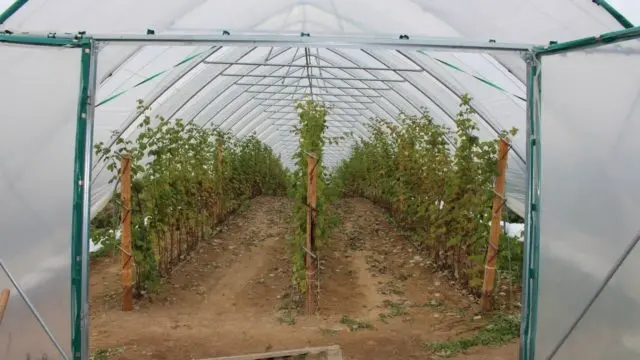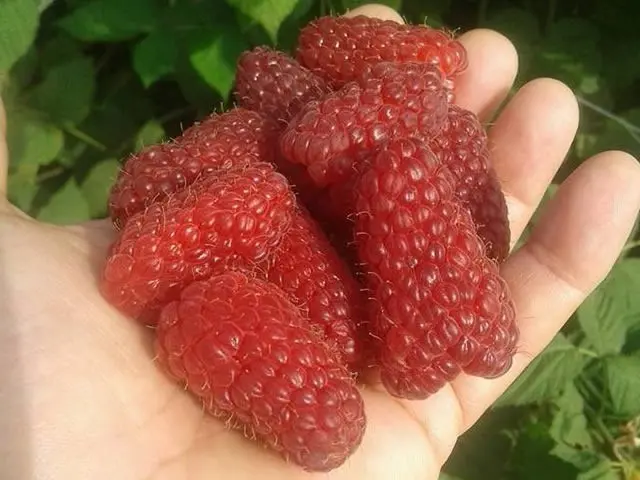Contents
The description of the Przehib raspberry is of interest not only to beginners, but also to experienced gardeners: this young variety, bred by Polish breeders, is famous for its very large berries. In gardens, he is still an infrequent guest, but every year his popularity is growing. Raspberry Pshehiba appeared in Our Country in 2017, when the first batch of planting material from Poland went on sale.
Description of the raspberry variety Pshehiba
Raspberry Pshehiba refers to varieties of summer raspberries, bears fruit on shoots of two years of age. This is an early variety – when cultivated in the southern regions, fruiting begins in early June, in Central Our Country they begin to harvest in the first decade of July. Raspberry Pshehiba also grows well in protected ground, at home the variety is successfully grown in tunnels, then the first berries can be harvested as early as the end of May.

Raspberry variety Pshehiba is characterized by active growth; on average, 5–7 tall shoots of medium thickness are formed on a bush per season. In open ground, the bush grows up to 2 m, in greenhouses the stems can reach a height of 2,5 m.
Young bright green shoots of raspberries are abundantly covered with short purple spikes, but their number decreases with age. The thorns do not interfere with the collection of berries and the care of plantings. Mature stems turn light brown and take on an anthocyanin hue.
The plant is covered with large, oval leaves of a bright green hue, having an elongated tip, the edges of the leaf plate are serrated.
The Pshehiba raspberry bush forms a large number of elastic fruit twigs, which can be up to 70 cm long.
Raspberry variety Pshehiba blooms in May with numerous large white flowers collected in inflorescences-brushes.
The fruits of Pshehiba are the real pride of the creators of the variety. In the photo of the Pshehiba raspberry variety, you can see smooth beautiful berries of the same shape, intense raspberry color; the descriptions indicate that when fully ripe they acquire a darker shade. The berries are large, medium length (30–50 mm), weighing up to 12 g. Some specimens can reach a record 14 g. The fruits are cylindrical, elongated, with blunt tops. The drupes are covered with a thin but strong skin, very juicy, with small seeds and a lot of pulp. 15-25 berries ripen on one bunch. The Pshehiba variety is characterized by abundant fruiting.

Raspberry Pshehiba is an extremely productive variety. In industrial cultivation, the yield, depending on agricultural technology and planting scheme, can reach 30 tons per hectare and even more. Up to 1,5 kg of berries are removed from one shoot. The yield of a bush depends on the number of stems.
Berries have a classic pleasant raspberry flavor and aroma. They can be used for processing, dried or frozen, consumed fresh. The fruits are well suited for sale, as they are stored for a long time, do not crumple and do not crumble.
Pshehib raspberries can be grown both on personal household plots and on an industrial scale.
Pros and cons of raspberry Przehiba
Raspberry Pshehiba is a truly outstanding variety – both in the descriptions of the plant and in the reviews, the following advantages are affirmed:
- best-in-class fruits with excellent taste;
- high stable yield;
- friendly fruiting;
- good immunity to diseases and pests;
- excellent frost resistance;
- resistance to heat and drought;
- relative undemanding to illumination: it can grow both in the sun and in partial shade;
- active vegetation;
- early ripening;
- ease of harvesting;
- high keeping quality;
- the possibility of cultivation in closed and open ground.
Of the shortcomings of the variety, the following are noted:
- sprawling form of the plant, involving the installation of supports;
- the need for regular pruning;
- high yields are achieved only with careful care;
- high price of planting material;
- insufficient experience of cultivation in the conditions of the climatic zones of Our Country does not yet allow drawing conclusions about the features of agricultural technology in different regions of the country.
Planting and caring for raspberries Pshehiba
Pshehib raspberries are planted in the same way as other varieties of this horticultural crop. You can plant it in the bush or tape method. It is preferable to use trench planting, since it will be easier to arrange supports for plants, in addition, it greatly simplifies the care of raspberries.
The Pshehiba variety needs regular watering, fertilizing and pruning. Periodically it is necessary to weed out weeds. Mulching the soil around the plants will help facilitate planting care.
Selection and preparation of the landing site
Raspberry Pshehiba can grow both in sunny areas and in partial shade, but in areas illuminated and protected from the winds, the fruits will ripen earlier and be sweeter. Most suitable for it is slightly acidic or neutral soil. You should choose a place so that in winter there is the maximum amount of snow, since raspberries hibernate best under heavy snow cover.
Before planting, the soil is dug up and plant residues are selected. So the earth will receive the necessary oxygen.
Rules of landing
Plants of raspberry Pshehiba should be located at least 75–80 cm apart, the optimal distance between rows is 150–200 cm. A denser planting negatively affects the general condition of the plants and yields.
The algorithm for planting raspberry Pshehib is as follows:
- dig a trench or planting holes;
- make a mixture of fertile soil, organic fertilizers and mineral complexes;
- place the cutting in a hole or trench;
- before filling the roots, the plant is watered;
- cover the seedling with fertile soil;
- cut the shoots to a height of 20-25 cm;
- mulch the soil.
Watering and top dressing
Drought resistance is one of the characteristics of the Pshehib raspberry, however, obtaining a good harvest is impossible without regular provision of plantings with moisture. Watering is especially important during the preparation of the plant for fruiting. At the same time, it is necessary to ensure that moisture does not stagnate at the roots, which provokes the infection of raspberries with fungal diseases. In hot, dry weather, watering is done no more than 1 time per week. In industrial cultivation, it is convenient to use the drip irrigation method.
Like other varieties of raspberries, Pshehiba is very sensitive to top dressing. It reacts especially well to organic matter: mullein, bird droppings, weeds. Gardeners prepare organic fertilizer as follows: a large barrel is filled a third with compost, cow dung and bird droppings. The mixture is poured with water and left for 2 weeks. The resulting solution is diluted with water in a ratio of 1:5.
The first time raspberries are fed in the spring, during the active growing season, then when the bushes fade and before winter, after picking the fruit. Mineral complexes for berry bushes are applied in accordance with the manufacturer’s recommendations.
Trimming
The main task of pruning raspberry Pshehiba is to stimulate the development of shoots. To do this, cut off the tops, which stimulates branching. The shoots that thicken the crown are cut off; 1–7 branches should remain per 8 m of the row. Root growth is also removed.
Since the Pshehib raspberry bears fruit on shoots of two years of age, after fruiting they must be cut off to activate the growth of new branches.
Sanitary pruning of raspberries is carried out in the spring. Remove frozen, weak, broken shoots. The remaining branches are shortened to the level of the first healthy kidney.
Preparation for winter
Frost resistance and resistance to freezing of buds is a hallmark of the Przehib raspberry. Despite this, in harsh winters, bushes need shelter for the winter. The shoots are removed from the supports, bent to the ground and covered with agrofiber or spruce branches. Shelter is built before the onset of cold weather, as the branches become brittle from frost.

As the experience of cultivating raspberries in Our Country has shown, in the southern regions the Pshehiba variety winters well without additional shelter.
Harvesting
Picking ripe raspberries is a laborious procedure that requires a lot of time. However, harvesting fruits of the Pshehiba variety is greatly simplified due to the large size of the berries, friendly ripening and density of drupes.
The fruiting period of raspberries is extended for several weeks, so ripe berries are removed every few days. To collect fruits, only small containers are used so that the berries do not crumple. Once harvested, raspberries of this variety will keep in the refrigerator for about a week.
Reproduction
The best ways to propagate raspberry Pshehib are cuttings and propagation by root shoots. It is most convenient to get new plants from root offspring during the planned thinning of the raspberry. The strongest and healthiest specimens are selected, they are dug out together with a clod of earth and immediately transplanted to a new place.
To get Pshehib raspberries from cuttings, shoots up to 25 cm long are cut in autumn, added dropwise and covered with spruce branches or film for the winter. Already in the spring they will turn out full-fledged plants.
It is possible to propagate raspberries by dividing the bush, but growing from seeds is not practiced, since the plants obtained in this way do not inherit the varietal characteristics of the mother crop.
Diseases and pests
A varietal feature of the Przehiba raspberry is its outstanding immunity to diseases and pests. Cases of infection of raspberry plantings of this variety are associated with significant errors in care.
Such diseases include, for example, late blight, which affects the plant due to moisture stagnation at the roots. A bush that has become ill with late blight quickly withers and dies. You can fight this disease with the help of fungicides.
Another common disease is raspberry rust. At risk are plants growing in regions with high humidity. Bulges of dark yellow color appear on the leaves, which become more and more over time. A bush affected by rust does not survive the winter. You can get rid of rust with the help of Bordeaux liquid or copper-containing preparations.

Of the raspberry pests, the most common are spider mites and aphids. They not only harm the plant themselves, but also serve as carriers of diseases. You can destroy pests using folk methods, for example, by treating raspberries with a solution of laundry soap, ash, garlic or onion peel. Spraying plantings with insecticides will also help.
To prevent diseases and pests, it is recommended to buy planting material only from trusted suppliers, provide plantings with proper care, destroy affected plants in a timely manner and observe crop rotation.
Conclusion
The description of the Pshehib raspberry will be supplemented as experience is gained in growing it in household plots and farms, but now we can say that the variety is rapidly gaining fans among gardeners. Habitual agricultural technology, resistance to diseases and pests, high yields and other advantages of the Przehib raspberry rightfully receive high marks and excellent reviews.









